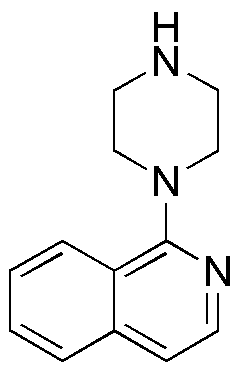1-Piperazin-1-yl-isoquinoline is widely utilized in research focused on:
- Pharmaceutical Development: This compound serves as a key intermediate in the synthesis of various pharmaceuticals, particularly those targeting neurological disorders, due to its ability to interact with specific receptors in the brain.
- Anticancer Research: It has shown potential in the development of anticancer agents, making it valuable for researchers working on novel treatments for different types of cancer.
- Material Science: The compound is explored for its properties in creating advanced materials, such as polymers and coatings, which can enhance durability and performance in various applications.
- Biochemical Studies: Its unique structure allows it to be used as a probe in biochemical studies, helping scientists understand complex biological processes and interactions at the molecular level.
- Drug Design: The compound is a useful scaffold in drug design, enabling researchers to modify its structure to improve efficacy and reduce side effects in therapeutic applications.
General Information
Properties
Safety and Regulations
Applications
1-Piperazin-1-yl-isoquinoline is widely utilized in research focused on:
- Pharmaceutical Development: This compound serves as a key intermediate in the synthesis of various pharmaceuticals, particularly those targeting neurological disorders, due to its ability to interact with specific receptors in the brain.
- Anticancer Research: It has shown potential in the development of anticancer agents, making it valuable for researchers working on novel treatments for different types of cancer.
- Material Science: The compound is explored for its properties in creating advanced materials, such as polymers and coatings, which can enhance durability and performance in various applications.
- Biochemical Studies: Its unique structure allows it to be used as a probe in biochemical studies, helping scientists understand complex biological processes and interactions at the molecular level.
- Drug Design: The compound is a useful scaffold in drug design, enabling researchers to modify its structure to improve efficacy and reduce side effects in therapeutic applications.
Documents
Safety Data Sheets (SDS)
The SDS provides comprehensive safety information on handling, storage, and disposal of the product.
Product Specification (PS)
The PS provides a comprehensive breakdown of the product’s properties, including chemical composition, physical state, purity, and storage requirements. It also details acceptable quality ranges and the product's intended applications.
Certificates of Analysis (COA)
Search for Certificates of Analysis (COA) by entering the products Lot Number. Lot and Batch Numbers can be found on a product’s label following the words ‘Lot’ or ‘Batch’.
*Catalog Number
*Lot Number
Certificates Of Origin (COO)
This COO confirms the country where the product was manufactured, and also details the materials and components used in it and whether it is derived from natural, synthetic, or other specific sources. This certificate may be required for customs, trade, and regulatory compliance.
*Catalog Number
*Lot Number
Safety Data Sheets (SDS)
The SDS provides comprehensive safety information on handling, storage, and disposal of the product.
DownloadProduct Specification (PS)
The PS provides a comprehensive breakdown of the product’s properties, including chemical composition, physical state, purity, and storage requirements. It also details acceptable quality ranges and the product's intended applications.
DownloadCertificates of Analysis (COA)
Search for Certificates of Analysis (COA) by entering the products Lot Number. Lot and Batch Numbers can be found on a product’s label following the words ‘Lot’ or ‘Batch’.
*Catalog Number
*Lot Number
Certificates Of Origin (COO)
This COO confirms the country where the product was manufactured, and also details the materials and components used in it and whether it is derived from natural, synthetic, or other specific sources. This certificate may be required for customs, trade, and regulatory compliance.


